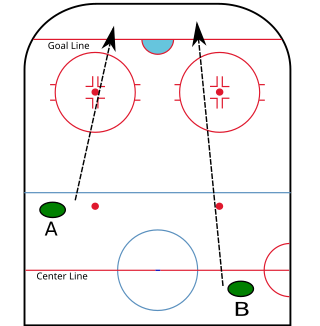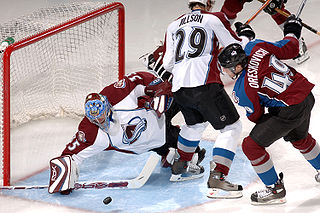Related Research Articles

Ice hockey is a team sport played on ice skates, usually on an ice skating rink with lines and markings specific to the sport. It belongs to a family of sports called hockey. In ice hockey, two opposing teams use ice hockey sticks to control, advance, and shoot a closed, vulcanized, rubber disc called a "puck" into the other team's goal. Each goal is worth one point. The team which scores the most goals is declared the winner. In a formal game, each team has six skaters on the ice at a time, barring any penalties, one of whom is the goaltender. Ice hockey is a full contact sport, and is considered to be one of the more physically demanding team sports. It is distinct from field hockey, in which players move a ball around a non-frozen pitch using field hockey sticks.

In many team sports that involve scoring goals, the goalkeeper is a designated player charged with directly preventing the opposing team from scoring by blocking or intercepting opposing shots on goal. Such positions exist in bandy, rink bandy, camogie, association football, Gaelic football, international rules football, floorball, handball, hurling, field hockey, ice hockey, roller hockey, lacrosse, ringette, rinkball, water polo, and shinty, as well as in other sports.

In ice hockey, a goal is scored when the puck entirely crosses the goal line between the two goal posts and below the goal crossbar. A goal awards one point to the team attacking the goal scored upon, regardless of which team the player who actually deflected the puck into the goal belongs to. Typically, a player on the team attempting to score shoots the puck with their stick towards the goal net opening, and a player on the opposing team called a goaltender tries to block the shot to prevent a goal from being scored against their team.
Short-handed is a term used in ice hockey and several related sports, including water polo, and refers to having fewer players on the ice during play, as a result of a penalty. The player removed from play serves the penalty in the penalty box for a set amount of time proportional to the severity of the infraction. If a goaltender commits a minor infraction, another player who was on the ice at the time of the penalty serves, often but not necessarily the team captain.

In ice hockey, icing is an infraction when a player touches the puck over the center red line and then opposing team's red goal line, and the puck remains untouched without scoring a goal.

Defence or defense in ice hockey is a player position that is primarily responsible for preventing the opposing team from scoring. They are often referred to as defencemen, D, D-men or blueliners. They were once called cover-point.

In ice hockey, the goaltender is the player responsible for preventing the hockey puck from entering their team's net, thus preventing the opposing team from scoring. The goaltender mostly plays in or near the area in front of the net called the goal crease. Goaltenders tend to stay at or beyond the top of the crease to cut down on the angle of shots. In the modern age of goaltending there are two common styles, butterfly and hybrid. Because of the power of shots, the goaltender wears special equipment to protect the body from direct impact.

A penalty in ice hockey is a punishment for an infringement of the rules. Most penalties are enforced by sending the offending player to a penalty box for a set number of minutes. During the penalty the player may not participate in play. Penalties are called and enforced by the referee, or in some cases, the linesman. The offending team may not replace the player on the ice, leaving them short-handed as opposed to full strength. When the opposing team is said to be on a power play, they will have one more player on the ice than the short-handed team. The short-handed team is said to be "on the penalty kill" until the penalty expires and the penalized player returns to play. While standards vary somewhat between leagues, most leagues recognize several common varieties of penalties, as well as common infractions.
In ice hockey, a penalty shot is a type of penalty awarded when a team loses a clear scoring opportunity on a breakaway because of a foul committed by an opposing player. A player from the non-offending team is given an attempt to score a goal without opposition from any defending players except the goaltender. This is the same type of shot used in a shootout to decide games in some leagues.

A shot in ice hockey is an attempt by a player to score a goal by striking or snapping the puck with their stick in the direction of the net.

A breakaway is a situation in ice hockey in which a player with the puck has no defending players, except for the goaltender, between himself and the opposing goal, leaving him free to skate in and shoot at will. A breakaway is considered a lapse on the part of the defending team. If a player's progress is illegally impeded by an opposing player or if the goalie throws his stick at the oncoming player, the breakaway player is awarded a penalty shot. If a player faces an empty net and is illegally impeded by an opposing player, he is automatically awarded a goal for his team instead of taking a penalty shot.
An extra attacker in ice hockey and ringette is a forward or, less commonly, a defenceman who has been substituted in place of the goaltender. The purpose of this substitution is to gain an offensive advantage to score a goal. The removal of the goaltender for an extra attacker is colloquially called pulling the goalie, resulting in an empty net. This article deals chiefly with situations which apply to the sport of ice hockey.

Roller in-line hockey, American roller hockey or inline hockey, is a variant of hockey played on a hard, smooth surface, with players using inline skates to move and ice hockey sticks to shoot a hard, plastic puck into their opponent's goal to score points. The sport is a very fast-paced and free-flowing game and is considered a contact sport, but body checking is prohibited. There are five players including the goalkeeper from each team on the rink at a time, while teams normally consist of 16 players. There are professional leagues, one of which is the National Roller Hockey League (NRHL). While it is not a contact sport, there are exceptions, i.e. the NRHL involves fighting.

The National Hockey League rules are the rules governing the play of the National Hockey League (NHL), a professional ice hockey organization. Infractions of the rules, such as offside and icing, lead to a stoppage of play and subsequent face-offs, while more serious infractions lead to penalties being assessed to the offending team. The league also determines the specifications for playing equipment used in its games.
This is a list of common terms used in the sport of ice hockey along with the definitions of these terms.
Delay of game is a penalty in ice hockey. It results in the offending player spending two minutes in the penalty box. In the NHL, delay of game is usually called under nine circumstances:
- A player or goaltender intentionally shoots or throws the puck out of the playing area.
- A defensive player in the defensive zone shoots the puck directly over the glass. This penalty only applies if the player shoots it over the glass. If the puck is shot into the bench, no penalty is assessed.
- A player or goaltender intentionally knocks the net's goalpost off its moorings, which stops the play. If the net is intentionally knocked loose during a breakaway, the breakaway player is awarded a penalty shot. If there is not enough time in the game to serve the full delay of game penalty, the last player to take a shot is also awarded a penalty shot.
- The player or goalie intentionally keeps the puck behind the net for more than a minute
- The goaltender freezes the puck rather than passing it on to a teammate when no player on the opposing team is within sufficient distance to apply offensive pressure to him.
- Any skater other than the goaltender uses their hands to make the puck unplayable.
- Fans begin to throw objects onto the ice or disrupt the game.
- Beginning from the 2017–18 NHL season, an unsuccessful coach's challenge for offside results in the challenging team being assessed a bench minor for delay of game.
- For adjustments to clothing, equipment, skates or sticks..
No goal is a call made by referees in various goal-scoring sports to indicate that a goal has not been scored. It is commonly used to disallow an apparent goal, such as when the ball or puck has entered the net but should not count as a score due to some foul or infraction.
The Hockey Canada Officiating Program is the governing body for on-ice officials for all ice hockey games played under the jurisdiction of Hockey Canada. The Hockey Canada Rulebook provides in-depth explanation and examples of all rules governing hockey in Canada.
The National Hockey League All-Star Skills Competition, officially the NHL All-Star Game SuperSkills Competition during certain past years, is an event on the night preceding the National Hockey League All-Star Game. Started at the 41st National Hockey League All-Star Game in Pittsburgh in 1990, the NHL uses the event to showcase the talents of its all-star participants. The All-Star teams select representatives for each event, with points awarded to the winning team.
References
- Podnieks, Andrew (2007). The Complete Hockey Dictionary. Fenn Publishing. ISBN 978-1-55168-309-6.
- ↑ Rule 25 – Awarded Goals, Official NHL rules
- ↑ Leahy, Sarah (13 December 2017). "Another league changes its rules, thanks to David Leggio". NBCsports.com. NBC. Retrieved 13 December 2017.
- ↑ NHL Public Relations (June 20, 2019). "NHL announces rule changes for 2019-20 season". NHL.com. National Hockey League. Retrieved June 21, 2019.
- ↑ "2018-19 NHL Official Rulebook" (PDF). NHL . Retrieved 3 March 2019.
Rule 25.4: Infractions – During the Course of a Penalty Shot: "A goal will be awarded when a goalkeeper attempts to stop a penalty shot by throwing his stick or any other object at the player taking the shot or by dislodging the goal (either deliberately or accidentally)."